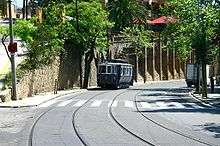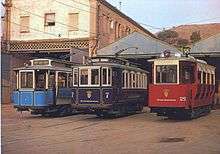Tramvia Blau
|
| ||||||||||||||||||||||||||||||||||||||||||||||||||||||||||||||||||||||||||||||||||||||||||||||||
| Overview | ||||||||||||||||||||||||||||||||||||||||||||||||||||||||||||||||||||||||||||||||||||||||||||||||
|---|---|---|---|---|---|---|---|---|---|---|---|---|---|---|---|---|---|---|---|---|---|---|---|---|---|---|---|---|---|---|---|---|---|---|---|---|---|---|---|---|---|---|---|---|---|---|---|---|---|---|---|---|---|---|---|---|---|---|---|---|---|---|---|---|---|---|---|---|---|---|---|---|---|---|---|---|---|---|---|---|---|---|---|---|---|---|---|---|---|---|---|---|---|---|---|---|
| Service type | Tramway | |||||||||||||||||||||||||||||||||||||||||||||||||||||||||||||||||||||||||||||||||||||||||||||||
| Locale | Barcelona | |||||||||||||||||||||||||||||||||||||||||||||||||||||||||||||||||||||||||||||||||||||||||||||||
| Route | ||||||||||||||||||||||||||||||||||||||||||||||||||||||||||||||||||||||||||||||||||||||||||||||||
| Start |
Plaça Kennedy (Avenida Tibidabo metro station) | |||||||||||||||||||||||||||||||||||||||||||||||||||||||||||||||||||||||||||||||||||||||||||||||
| End |
Plaça del Doctor Andreu (Funicular del Tibidabo) | |||||||||||||||||||||||||||||||||||||||||||||||||||||||||||||||||||||||||||||||||||||||||||||||
| Distance travelled | 1.276 kilometres (0.793 mi) | |||||||||||||||||||||||||||||||||||||||||||||||||||||||||||||||||||||||||||||||||||||||||||||||
| Technical | ||||||||||||||||||||||||||||||||||||||||||||||||||||||||||||||||||||||||||||||||||||||||||||||||
| Track gauge | 1,435 mm (4 ft 8 1⁄2 in) standard gauge | |||||||||||||||||||||||||||||||||||||||||||||||||||||||||||||||||||||||||||||||||||||||||||||||
| Track owner(s) | Transports Metropolitans de Barcelona | |||||||||||||||||||||||||||||||||||||||||||||||||||||||||||||||||||||||||||||||||||||||||||||||
| ||||||||||||||||||||||||||||||||||||||||||||||||||||||||||||||||||||||||||||||||||||||||||||||||
The Tramvia Blau (Catalan for "blue tramway") is one of Barcelona's three tram systems. It is a 1.276 kilometres (0.793 mi) long heritage streetcar line serving a hilly area of the Sarrià-Sant Gervasi district between the terminus of FGC Barcelona Metro L7 and the Funicular del Tibidabo.[1][2][3]
The Tramvia Blau is operated by Transports Metropolitans de Barcelona (TMB) but it is not part of Autoritat del Transport Metropolità (ATM) integrated fare network. Tickets must be purchased from the tram conductor.[1]
The Tramvia Blau is one of only two first generation tramways to survive in Spain, along with the Tranvía de Sóller on the island of Majorca.[4]
History
The line was built at the instigation of Sr.Salvador Andreu, who was building a residential project around the axis of the Avenida Tibidabo, and was inaugurated in 1901. The line connected at Plaça Kennedy with trams of Barcelona's city system, but was independently owned. The line's own distinctive blue livery soon led to it becoming known as the Tramvia Blau.[1]
The line suffered several changes in 1922 and 1958.
In 1954, line 7 of the Barcelona Metro was opened to Avinguda Tibidabo station under Plaça Kennedy, providing another connection to central Barcelona. However, in the 1960s the city trams were withdrawn from Plaça Kennedy, cutting the Tramvia Blau off from the city network.[1][5][6]
In 1971 the remaining tram routes of the Tranvías de Barcelona company were closed. However, the separately owned Tramvia Blau remained in operation. It continued in private ownership until 1979, when it was taken over by the city, who continued to operate it. Between 1971 and 2004, when the second generation Trambaix and Trambesòs lines opened, it was the only tram route in the city.[1][2]
Operation
Infrastructure

The Tramvia Blau is 1.276 kilometres (0.793 mi) long, climbing a vertical distance of 93 metres (305 ft) at a maximum gradient of 8%. It is constructed to 1,435 mm (4 ft 8 1⁄2 in) gauge and is double track, apart from single track stub terminals at each terminus. It runs in the Avinguda Tibidabo throughout, and is not segregated from other traffic.[1]
The line's depot is accessed by some 100 metres (330 ft) of single track, which is not used in passenger service. The depot branch joins the main line near its midpoint, adjacent to the bridge carrying the Avinguda Tibidabo over the Ronda de Dalt.[1]
The line serves the following stops:[1]
| Uphill | Downhill |
|---|---|
|
|
Tram fleet

The line is operated with a fleet of seven historic tram cars:
| Image | Number | Year | Notes |
|---|---|---|---|
| 2 | 1901 | The only survivor of a class of four trams built for the opening of the Tramvia Blau. Is operable, but only used on special occasions.[1][2] | |
| |
5,8,10 | 1904 | Members of a further class of six four-wheeled trams built for service on the Tramvia Blau. The cars are double-ended, with two doors on each side with manually operated gates. Each car has a capacity for 32 seated passengers, and has a maximum speed of 13 km/h (8.1 mph).[1][2][3] |
| |
6,7 | 1904 | Members of the same class as 5, 8 and 10, but rebuilt in 2005 to 2006. The rebuilt cars retain their original layout and propulsion, with the addition of hydraulic brakes.[1][2][3] |
| |
129 | 1906 | Open car originally built for the Barcelona city system. Restored in 1986, using the truck from Tramvia Blau tram 9, of the same class as 5-8 and 10. Painted in the traditional red of the Barcelona city system rather than the blue of the Tramvia Blau.[1][2] |
See also
References
- 1 2 3 4 5 6 7 8 9 10 11 12 "El Tramvia Blau" (in Catalan). trenscat.com. Retrieved 2013-12-19.
- 1 2 3 4 5 6 "Tramvia Blau" (in Spanish). tramvia.org. Retrieved 2013-12-19.
- 1 2 3 "Case story Tramvia Blau (Blue Tram), Barcelona" (PDF). Dellner Brakes AB. Retrieved 2013-12-20.
- ↑ Bent, Mike (January 2014). "Sóller tramway centenary". Today's Railways. Platform 5 Publishing Ltd. p. 71.
- ↑ "Tram map - Barcelona 1964". http://www.tundria.com/. Retrieved 2013-12-20. External link in
|work=(help) - ↑ "Tram map - Barcelona 1966". http://www.tundria.com/. Retrieved 2013-12-20. External link in
|work=(help)
External links
-
 Media related to Tramvia Blau at Wikimedia Commons
Media related to Tramvia Blau at Wikimedia Commons - Tramvia Blau page on the TMB web site
Coordinates: 41°24′51″N 2°08′03″E / 41.414201°N 2.134073°E